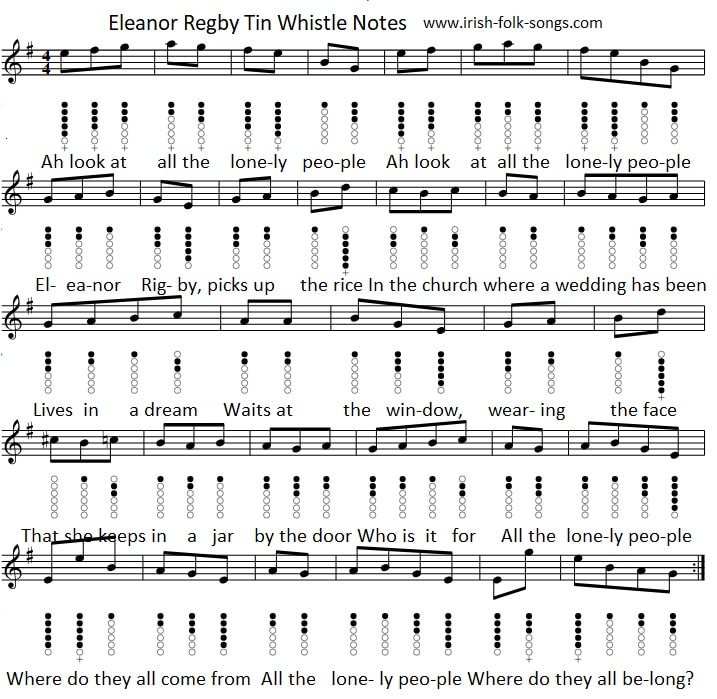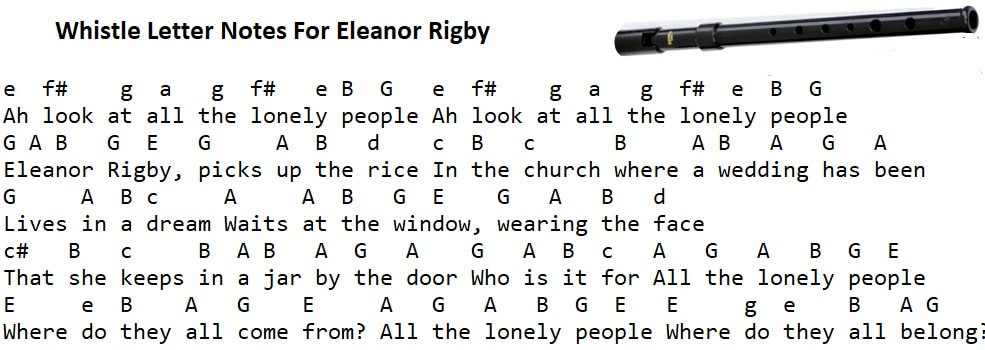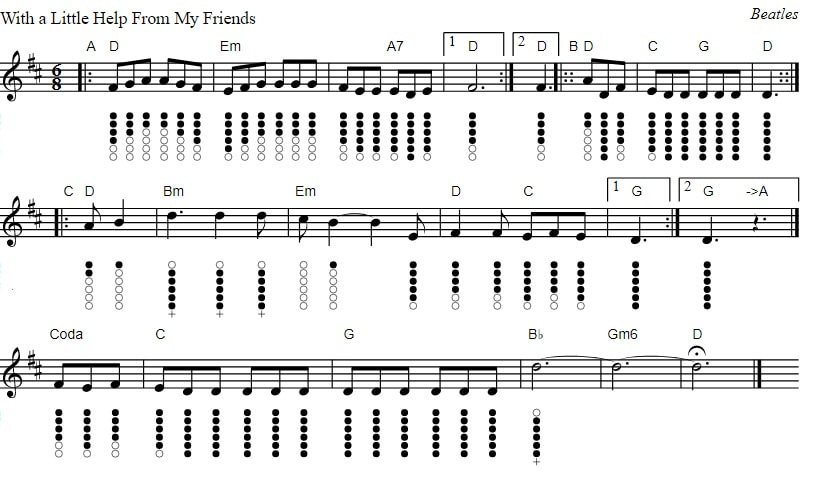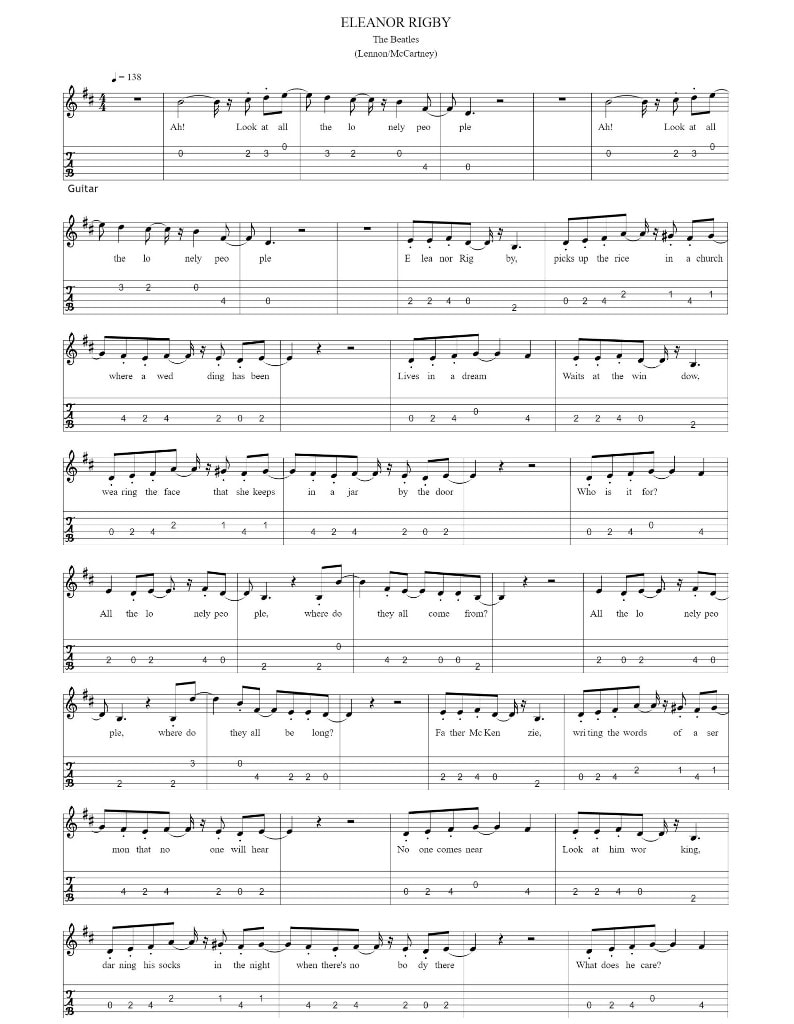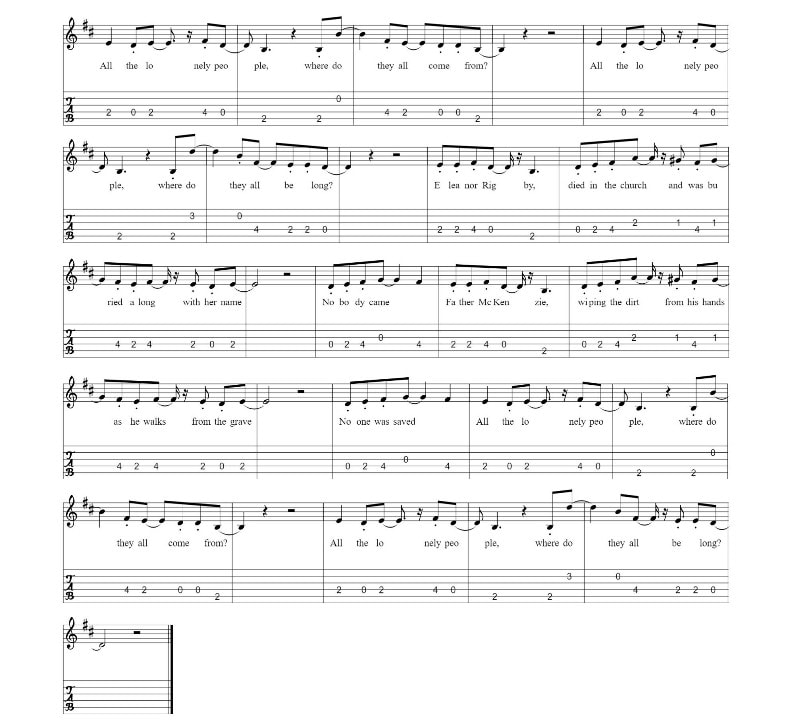Eleanor Rigby Tin Whistle Notes By The Beatles
The notes to this Beatles go very high in places, up as far as the high A. I have included the basic easy letter notation for accordion / flute / recorder players. The words and music are by Paul McCartney and the late John Lennon. The sheet music tab is in G Major. The whistle notes were worked out on a D whistle and that's the one to use. With a little help from my friends tin whistle notes by the Beatles in the key of D . Eleanor Rigby guitar tab fingerstyle included.
The song 'Eleanor Rigby' has become a timeless classic in the realm of popular music, with its haunting melody and poignant lyrics continuing to captivate listeners nearly six decades after its release. Written by the iconic British band, The Beatles, and released in 1966 as a part of their seminal album 'Revolver', 'Eleanor Rigby' has transcended generations and cultures, becoming a cultural phenomenon and a subject of intense critical analysis. Through its rich symbolism and thought-provoking themes, the song not only provides a window into the turbulent social and cultural climate of the 1960s but also serves as a powerful commentary on the universal human experience of loneliness, isolation, and the search for meaning in a seemingly indifferent world.
At its core, 'Eleanor Rigby' tells the story of two individuals, the eponymous Eleanor Rigby and Father McKenzie, both leading isolated and lonely lives, despite their roles as a caretaker and a clergyman, respectively. The song opens with the lyrics 'Ah look at all the lonely people', setting the tone for the entire narrative and highlighting the theme of loneliness that permeates throughout the song. Eleanor Rigby, an elderly woman who 'keeps her face in a jar by the door' and 'waits at the window, wearing the face that she keeps in a jar by the door', is depicted as living a monotonous and mundane existence, devoid of any human connection. Similarly, Father McKenzie, who 'darning his socks in the night when there's nobody there' and 'writing the words of a sermon that no one will hear', is portrayed as a solitary figure, struggling to find solace in his faith while being surrounded by a congregation who is 'kept in a jar by the door'. The use of the phrase 'lonely people' in the chorus further emphasizes the feeling of isolation and highlights the shared experience of these two characters, despite their vastly different backgrounds.
One of the most striking aspects of 'Eleanor Rigby' is the use of vivid and evocative imagery to convey its themes. The image of 'faces in jars by the door' is a powerful metaphor for the way in which society often compartmentalizes and dehumanizes individuals, reducing them to mere objects or labels. This is further reinforced by the repeated mention of the phrase 'all the lonely people', which implies a sense of collective anonymity and detachment from society. The lyrics also paint a bleak and desolate picture of the characters' surroundings, with 'wearing the face that she keeps in a jar by the door' and 'darning his socks in the night' evoking a sense of confinement and entrapment. Furthermore, the use of the word 'no one' in the lyrics, such as 'no one will hear' and 'no one comes near', emphasizes the characters' sense of alienation and the absence of meaningful human connections in their lives.
The song's chorus, with its repeated refrain of 'all the lonely people, where do they all come from?' serves as a powerful reminder of the pervasive nature of loneliness in society. The lyrics not only question the origins of this loneliness but also imply a sense of helplessness and confusion towards finding a solution. This theme of existential questioning is further reinforced in the second verse, where the lyrics 'Eleanor Rigby, died in the church and was buried along with her name, nobody came' suggests the futility of life and the inevitability of death, regardless of one's social status or achievements. This is contrasted with the image of Father McKenzie, who is 'writing the words of a sermon that no one will hear', highlighting the emptiness and lack of purpose in his life, despite his position as a religious figure.
Moreover, the use of the name 'Eleanor Rigby' has sparked numerous interpretations and speculations as to the inspiration behind the character. Some have suggested that the name was derived from a gravestone that John Lennon had seen in a cemetery, while others have speculated that it was a combination of two individuals, Eleanor Bron and Rigby & Evans Ltd, a wine and spirit merchant in Bristol. This ambiguity surrounding the character's name adds another layer of mystery and intrigue to the song, allowing listeners to project their own interpretations onto the character and her story.
In conclusion, 'Eleanor Rigby' is a powerful and thought-provoking song that delves into the universal human experience of loneliness and the search for meaning in a seemingly indifferent world. Through its vivid imagery, evocative lyrics, and haunting melody, the song continues to resonate with listeners of all ages and backgrounds, making it a timeless classic in the realm of popular music. Its enduring popularity and cultural significance serve as a testament to the enduring impact of The Beatles' music and their ability to capture the essence of the human experience through their art.
At its core, 'Eleanor Rigby' tells the story of two individuals, the eponymous Eleanor Rigby and Father McKenzie, both leading isolated and lonely lives, despite their roles as a caretaker and a clergyman, respectively. The song opens with the lyrics 'Ah look at all the lonely people', setting the tone for the entire narrative and highlighting the theme of loneliness that permeates throughout the song. Eleanor Rigby, an elderly woman who 'keeps her face in a jar by the door' and 'waits at the window, wearing the face that she keeps in a jar by the door', is depicted as living a monotonous and mundane existence, devoid of any human connection. Similarly, Father McKenzie, who 'darning his socks in the night when there's nobody there' and 'writing the words of a sermon that no one will hear', is portrayed as a solitary figure, struggling to find solace in his faith while being surrounded by a congregation who is 'kept in a jar by the door'. The use of the phrase 'lonely people' in the chorus further emphasizes the feeling of isolation and highlights the shared experience of these two characters, despite their vastly different backgrounds.
One of the most striking aspects of 'Eleanor Rigby' is the use of vivid and evocative imagery to convey its themes. The image of 'faces in jars by the door' is a powerful metaphor for the way in which society often compartmentalizes and dehumanizes individuals, reducing them to mere objects or labels. This is further reinforced by the repeated mention of the phrase 'all the lonely people', which implies a sense of collective anonymity and detachment from society. The lyrics also paint a bleak and desolate picture of the characters' surroundings, with 'wearing the face that she keeps in a jar by the door' and 'darning his socks in the night' evoking a sense of confinement and entrapment. Furthermore, the use of the word 'no one' in the lyrics, such as 'no one will hear' and 'no one comes near', emphasizes the characters' sense of alienation and the absence of meaningful human connections in their lives.
The song's chorus, with its repeated refrain of 'all the lonely people, where do they all come from?' serves as a powerful reminder of the pervasive nature of loneliness in society. The lyrics not only question the origins of this loneliness but also imply a sense of helplessness and confusion towards finding a solution. This theme of existential questioning is further reinforced in the second verse, where the lyrics 'Eleanor Rigby, died in the church and was buried along with her name, nobody came' suggests the futility of life and the inevitability of death, regardless of one's social status or achievements. This is contrasted with the image of Father McKenzie, who is 'writing the words of a sermon that no one will hear', highlighting the emptiness and lack of purpose in his life, despite his position as a religious figure.
Moreover, the use of the name 'Eleanor Rigby' has sparked numerous interpretations and speculations as to the inspiration behind the character. Some have suggested that the name was derived from a gravestone that John Lennon had seen in a cemetery, while others have speculated that it was a combination of two individuals, Eleanor Bron and Rigby & Evans Ltd, a wine and spirit merchant in Bristol. This ambiguity surrounding the character's name adds another layer of mystery and intrigue to the song, allowing listeners to project their own interpretations onto the character and her story.
In conclusion, 'Eleanor Rigby' is a powerful and thought-provoking song that delves into the universal human experience of loneliness and the search for meaning in a seemingly indifferent world. Through its vivid imagery, evocative lyrics, and haunting melody, the song continues to resonate with listeners of all ages and backgrounds, making it a timeless classic in the realm of popular music. Its enduring popularity and cultural significance serve as a testament to the enduring impact of The Beatles' music and their ability to capture the essence of the human experience through their art.
The alternative version of the tab in the youtube video is by Fiddling With My Tin Whistle.
With a little help from my friends tin whistle notes by the Beatles
Below is the list of sheet music and tin whistle songs that are in my ebooks. This is the largest collection of tin whistle songs ever put together.[over 800 songs ] Including folk, pop and trad tunes plus German And French songs along with Christmas Carols.
All of the sheet music tabs have been made as easy to play as was possible.
The price of the ebooks is €7.50
All of the sheet music tabs have been made as easy to play as was possible.
The price of the ebooks is €7.50
